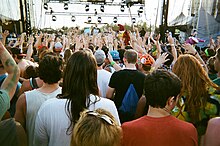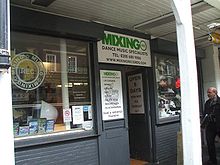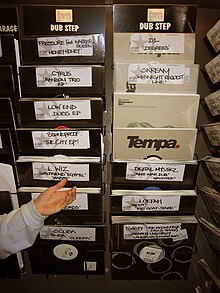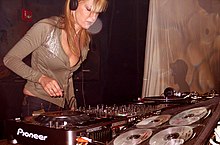History
The earliest dubstep releases date back to 1998 and were darker, more experimental, instrumental dub remixes of 2-step garage tracks attempting to incorporate the funky elements of breakbeat, or the dark elements of drum and bass into 2-step, which featured B-sides of single releases. In 2001, this and other strains of dark garage music began to be showcased and promoted at London's night club Plastic People, at the "Forward" night (sometimes stylized as FWD>>), which went on to be considerably influential to the development of dubstep. The term "dubstep" in reference to a genre of music began to be used by around 2002, by which time stylistic trends used in creating these remixes started to become more noticeable and distinct from 2-step and grime. It was labels Big Apple, Amunition and Tempa that began circulating the "dubstep" term.[2]
A very early supporter of the sound was BBC Radio 1 DJ John Peel, who started playing it from 2003 onwards. In 2004, the last year of his show, his listeners voted Distance, Digital Mystikz and Plastician (formerly Plasticman) in their top 50 for the year.[3] Dubstep started to spread beyond small local scenes in late 2005 and early 2006; many websites devoted to the genre appeared on the internet and aided the growth of the scene, such as dubstepforum, the download site Barefiles and blogs such as gutterbreakz.[4] Simultaneously, the genre was receiving extensive coverage in music magazines such as The Wire and online publications such as Pitchfork Media, with a regular feature entitled The Month In: Grime/Dubstep. Interest in dubstep grew significantly after BBC Radio 1 DJ Mary Anne Hobbs started championing the genre, beginning with a show devoted to it (entitled "Dubstep Warz") in January 2006.[5][6][7]
1999–2002: origins
The sound of dubstep originally came out of productions by El-B,[8] Steve Gurley,[8] Oris Jay,[12] and Zed Bias[24][25] in 1999-2000. Ammunition Promotions, who run the influential club Forward>> and have managed many proto dubstep record labels (including Tempa, Soulja, Road, Vehicle, Shelflife, Texture, Lifestyle and Bingo),[6][12] began to use the term "dubstep" to describe this style of music in around 2002. The term's use in a 2002 XLR8R cover story (featuring Horsepower Productions on the cover) contributed to it becoming established as the name of the genre.[24][26]
The club Forward>> was originally held at the Velvet Rooms in London's Soho and is now running every Thursday at Plastic People in Shoreditch, east London.[10] Founded in 2001, Forward>> was critical to the development of dubstep, providing the first venue devoted to the sound and an environment in which dubstep producers could premier new music.[27] Around this time, Forward>> was also incubating several other strains of dark garage hybrids, so much so that in the early days of the club the coming together of these strains was referred to as the "Forward>> sound".[28] An online flyer from around this time encapsulated the Forward>> sound as "b-lines to make your chest cavity shudder."[29]
Forward>> also ran a radio show on east London pirate station Rinse FM, hosted by Kode9.[30] The original Forward>> line ups included Hatcha, Youngsta, Kode9, Zed Bias, Oris Jay,[12] Slaughter Mob, Jay Da Flex, Slimzee and others, plus regular guests. The line up of residents has changed over the years to include Youngsta, Hatcha, Geeneus and Plastician, with Crazy D as MC/host. Producers including D1, Skream and Benga make regular appearances.[27]
Another crucial element in the early development of dubstep was the Big Apple Records record shop in Croydon.[6] Key artists such as Hatcha and later Skream worked in the shop (which initially sold early UK Hardcore / Rave, Techno and House and later, garage and drum and bass, but evolved with the emerging dubstep scene in the area),[8] while Digital Mystikz were frequent visitors. El-B, Zed Bias, Horsepower Productions, Plastician, N Type, Walsh and a young Loefah regularly visited the shop as well.[6] The shop and its record label have since closed down[24] and reopened under the name Mixing Records under new management before closing down again in 2010. The shop's site is currently unused and still stands in the north end of Surrey Street, Croydon.
In an article in The Guardian, Simon Reynolds examined the idea of any links between the recreational use of ketamine, a dissociative drug, and the origins of dubstep, writing that a connection "would certainly explain a lot", though also conceding "it could all be just rumour".[31]
2002–2005: evolution

Throughout 2003, DJ Hatcha pioneered a new direction for dubstep on Rinse FM and through his sets at Forward>>.[6][25] Playing sets cut to 10" one-off reggae-style dubplates, he drew exclusively from a pool of new South London producers—first Benga and Skream,[25] then also Digital Mystikz and Loefah—to begin a dark, clipped and minimal new direction in dubstep.[32]
At the end of 2003, running independently from the pioneering FWD night, an event called Filthy Dub, co promoted by Plastician, and partner David Carlisle started happening regularly. It was there that Skream, Benga, N Type, Walsh, Chef, Loefah and Cyrus made their debuts as DJ's. South London collective Digital Mystikz (Mala and Coki), along with labelmates and collaborators Loefah and MC Sgt Pokes soon came into their own, bringing sound system thinking, dub values, and appreciation of jungle bass weight to the dubstep scene.[24] Digital Mystikz brought an expanded palette of sounds and influences to the genre, most prominently reggae and dub, as well as orchestral melodies.[33]
After releasing 12-inch singles on Big Apple, they founded DMZ Records, which has released fourteen 12"s to date. They also began their night DMZ, held every two months in Brixton,[34] a part of London already strongly associated with reggae.[35] DMZ has showcased new dubstep artists such as Skream, Kode 9, Benga, Pinch, DJ Youngsta, Hijak, Joe Nice and Vex'd. DMZ's first anniversary event (at the Mass venue, a converted church) saw fans attending from places as far away as Sweden, the U.S., and Australia, leading to a queue of 600 people[36] at the event. This forced the club to move from its regular 400-capacity space[7] to Mass' main room, an event cited as a pivotal moment in dubstep's history.[12][37]
In 2004, Richard James' label, Rephlex, released two compilations that included dubstep tracks - the (perhaps misnamed) Grime and Grime 2. The first featured Plasticman, Mark One and Slaughter Mob,[38] with Kode 9, Loefah and Digital Mystikz appearing on the second.[39] These compilations helped to raise awareness of dubstep at a time when the grime sound was drawing more attention,[24] and Digital Mystikz and Loefah's presence on the second release contributed to the success of their DMZ club night.[40] Soon afterwards, the Independent on Sunday commented on "a whole new sound", at a time when both genres were becoming popular, stating that "grime" and "dubstep" were two names for the same style, which was also known as "sublow", "8-bar" and "eskibeat".[41]
2005–2008: growth
In the summer of 2005, Forward>> brought grime DJs to the fore of the line up.[42] Building on the success of Skream's grimey anthem "Midnight Request Line," the hype around the DMZ night and support from online forums (notably dubstepforum.com)[10] and media,[7] the scene gained prominence after former Radio 1 DJ Mary Anne Hobbs gathered top figures from the scene for one show, entitled "Dubstep Warz", (later releasing the compilation album Warrior Dubz).[36] The show created a new global audience for the scene, after years of exclusively UK underground buzz.[10] Burial's self-titled album appearing in many critics' "Best of..." lists for the year, notably The Wire's Best Album of 2006.[43] The sound was also featured prominently in the soundtrack for the 2006 sci-fi film Children of Men,[44] which included Digital Mystikz, Random Trio, Kode 9, Pressure and DJ Pinch.[45] Ammunition also released the first retrospective compilation of the 2000-2004 era of dubstep called The Roots of Dubstep, co-compiled by Ammunition and Blackdown on the Tempa Label.[46]
The sound's first North American ambassador, Baltimore DJ Joe Nice helped kickstart its spread into the continent.[10] Regular Dubstep club nights started appearing in cities like New York,[47] San Francisco,[26] Seattle, Montreal, Houston, and Denver,[48] while Mary Anne Hobbs curated a Dubstep showcase at 2007's Sónar festival in Barcelona.[12] Non-British artists have also won praise within the larger Dubstep community.[12] The dynamic dubstep scene in Japan is growing quickly despite its cultural and geographical distance from the West. Such DJ/producers as Goth-trad, Hyaku-mado, Ena and Doppelganger are major figures in the Tokyo scene.[49] Joe Nice has played at DMZ,[50] while the fifth installment of Tempa's "Dubstep Allstars" mix series (released in 2007) included tracks by Finnish producer Tes La Rok and Americans JuJu and Matty G.[51] Following on from Rinse FM's pioneering start; three internet based radio station's called SubFM, DubstepFM and DubTerrain started to play the sound exclusively with 24 hour broadcasting featuring show archives and live DJ shows.
Techno artists and DJs began assimilating dubstep into their sets and productions.[12] Shackleton's "Blood On My Hands" was remixed by minimal techno producer Ricardo Villalobos (an act reciprocated when Villalobos included a Shackleton mix on his "Vasco" EP)[52] and included on a mix CD by Panoramabar resident Cassy.[12] Ellen Allien and Apparat's 2006 song "Metric" (from the Orchestra of Bubbles album),[53][54] Modeselektor's "Godspeed" (from the 2007's Happy Birthday! album, among other tracks on that same album) and Roman Flugel's remix of Riton's "Hammer of Thor" are other examples of dubstep-influenced techno.[12] Berlin's Hard Wax record store (operated by influential[55] dub techno artists Basic Channel)[56][57] has also championed Shackleton's Skull Disco label, later broadening its focus to include other dubstep releases.[11]
The summer of 2007 saw dubstep's musical palette expand further, with Benga and Coki scoring a crossover hit (in a similar manner to Skream's "Midnight Request Line") with the track "Night", which gained widespread play from DJs in a diverse range of genres. BBC Radio 1 DJ Gilles Peterson named it his record of 2007, and it was also a massive hit in the equally bassline-orientated, but decidedly more four-to-the-floor genre of bassline house,[58] whilst Burial's late 2007 release Untrue (which was nominated for the 2008 Nationwide Mercury Music Prize in the UK) incorporated extensive use of heavily manipulated, mostly female, 'girl next door' vocal samples.[59] Burial has spoken at length regarding his intent to reincorporate elements of musical precursors such as 2-step garage and house into his sound.[60]
Much like drum and bass before it, dubstep has started to become incorporated into other media, particularly in the United Kingdom. In 2007, Benga, Skream, and other dubstep producers provided the soundtrack to much of the second series of Dubplate Drama, which aired on Channel 4 with a soundtrack CD later released on Rinse Recordings. The sound also featured prominently in the second series of the teen drama Skins, which also aired on Channel 4 in early 2008.
In the summer of 2008, Mary Anne Hobbs invited Cyrus, Starkey, Oneman, DJ Chef, Silkie, Quest, Joker, Nomad, Kulture and MC Sgt Pokes to the BBC's Maida Vale studios for a show called Generation Bass.[61][62][63][64] The show was the evolution from her seminal BBC Radio 1 Dubstepwarz Show in 2006, and further documented another set of dubstep's producers.
In the autumn of 2008, a limited pressing 12" called "Iron Devil"[65] was released featuring Lee Scratch Perry and Prince Far-I in a dubstep style, including a tune based on the Perry riddim used on reggae hits like "Disco Devil", "Chase The Devil", and "Croaking Lizard". This was the first recorded example of a founder of Jamaican dub style acknowledging dubstep and creating new music in the genre, reinforcing the connection of dubstep to its roots in Jamaican dub reggae at a time when it seemed dubstep was moving away from its reggae underpinnings.
As the genre has spread to become an international rather than UK-centric scene, it has also seen a number of women making headway into the scene in a variety of ways. Alongside Soulja of Ammunition Promotions and Mary Anne Hobbs, an influx of female producers, writers, photographers and DJs all have broken through in the up-til-then male orientated scene. With key 12" releases on Hyperdub,Immigrant andHotflush Recordings, producers Vaccine, Subeena and Ikonika have introduced a palette of new sounds and influences to the genre, such as double-time bass drums, 8-bit video game samples, hand percussion and lushly arranged strings.[66] Mary Anne Hobbs commented that the mood at dubstep nights is less aggressive, or more meditative, leading to a larger female attendance at events than with the genre's precursors, noting "Grime and drum 'n' bass raves tend to be quite aggy. People in dubstep clubs tend to have a more meditative approach, which is inviting to females. You see the female-to-male ratio constantly going up – it’s got the potential to be 40:60".[66]
Journalists Melissa Bradshaw,[67][68] Emma Warren,[69][70] and dubstep documentarian and photographer Georgina Cook have all had an impact on the cultural importance of the music. Cook's Drumz of the South flickr page documents the evolution of the scene in a photographic timeline of sorts, and was for a time the only photographic archive of the key events such as the early FWD and DMZ nights in London.[66][71][72][73][74]
2009-present
Mainstream influence

The influence of dubstep on more commercial or popular genres can be identified as far back as 2007, with artists such as Britney Spears using dubstep sounds; critics observed a dubstep influence in the song "Freakshow", from the 2007 album Blackout, which Tom Ewing described as "built around the 'wobbler' effect that's a genre standby."[75][76] Benga and Coki's single "Night" still continued to be a popular track on the UK dance chart more than a year after its release in late 2007, still ranking in the top five at the start of April 2008 on Pete Tong's BBC Radio 1 dance chart list.[77]
However the year 2009 saw the dubstep sound gaining further worldwide recognition, often through the assimilation of elements of the sound into other genres, in a manner similar to drum and bass before it. At the start of the year, UK electronic duo La Roux put their single "In for the Kill" in the remix hands of Skream.[78][79] They then gave remix duties of "I'm Not Your Toy" to Nero and then again with their single "Bulletproof" being remixed by Zinc. The same year, London producer Silkie released an influential album City Limits Vol. 1 on the Deep Medi label, using 70s funk and soul reference points, a departure from the familiar strains of dub and UK garage.[80] A key factor in the rise of dubstep in the media was its exposure on video sharing websites, such as YouTube who provide access to many channels dedicated to dubstep, notably UKF Dubstep. The sound also continued to interest the mainstream press with key articles in magazines like Interview, New York, and The Wire, which featured producer Kode9 on its May 2009 cover. XLR8R put Joker on the cover of its December 2009 issue.[18][81][82][83] By the end of 2009, The New York Times, XLR8R, NME and The Sunday Times all reviewed the genre.[84][85][86][87]
In a move foreshadowed by endorsements of the sound from R&B, hip-hop and recently, mainstream figures such as Rihanna, or Public Enemy's Hank Shocklee,[88] Snoop Dogg collaborated with dubstep producers Chase & Status, providing a vocal for their 'underground anthem' "Eastern Jam".[89] The 2011 Britney Spears track "Hold It Against Me" was also responsible for promoting dubstep tropes within a mainstream pop audience,.[90] Rihanna's Rated R album released such content the very year dubstep saw a spike, containing 3 dubstep tracks.[91] Such events propelled the genre into the biggest radio markets overnight, with considerable airplay.[92] Other hip-hop artists like Xzibit added their vocals to dubstep instrumental tracks for the mixtape project Mr Grustle & Tha Russian Dubstep LA Embrace The Renaissance Vol. 1 Mixed by Plastician.[92][93] In summer 2009, female rapper and actress Eve used Benga's "E Trips"; adding her own verses over the beat to create a new tune called "Me N My"; the first single on her album Flirt. The track was co-produced by Benga and hip hop producer Salaam Remi.[94][95]
Throughout 2010, dubstep was beginning to hit the pop charts, with "I Need Air" by Magnetic Man reaching number 10 in the UK singles chart. This presented a turning point in the popularity of mainstream dubstep amongst UK listeners as it was placed on rotation on BBC Radio 1.[96] "Katy On a Mission" by Katy B (produced by Benga) followed, debuting at number 5 in the UK singles chart, and stayed in the top 10 for five more weeks.[97] In February 2011, Chase & Status's second album No More Idols reached No.2 in the UK album chart.[98] On May 1, 2011, Nero's third single "Guilt" from their album reached number 8 in the Official UK Singles Chart.[99] Nero and DJ Fresh both had number one singles in 2011 with "Louder" and "Promises".[100] In April 2011, "dubbox", the industry's first application designed for the mobile creation of dubstep music, was released for the iPhone and reached the Top 25 Best Selling Music Apps in the UK its first week.
Post-dubstep
More recently the term post-dubstep has been used to describe music that combines stylistic features of dubstep with other musical influences.The breadth of styles that have come to be associated with the term post-dub-step preclude it from being a specific musical genre. Pitchfork writer Martin Clark has suggested that "well-meaning attempts to loosely define the ground we're covering here are somewhat futile and almost certainly flawed. This is not one genre. However, given the links, interaction, and free-flowing ideas...you can't dismiss all these acts as unrelated..."[101] Such music often references earlier dubstep productions as well as UK Garage, 2-step, and other forms of underground electronic dance music.[102][103][104] Artists producing music that has been described as post-dubstep have also incorporated elements of ambient music and early 2000s R&B. The latter in particular is heavily sampled by three artists described as post-dubstep, Mount Kimbie, Fantastic Mr Fox and James Blake.[105][106] The tempo of music typically characterised as post-dubstep is approximately 130 beats per minute.[101]
The production duo Mount Kimbie is often associated with the origination of the term post-dubstep.[107] The commercial popularity of The xx, also marked a breakaway and a member of the band, Jamie xx has released remixes which are considered post-dubstep, including a Gil Scott-Heron remix album.[102] Other names frequently associated with post-dubstep are Ikonika, 2562, Cityscape, Deadboy, Martyn, Floating Points, Pangaea, Ramadanman, Sepalcure, FaltyDL, Pariah, Burial, The Weeknd, SBTRKT, Lorena B, Scuba, Egyptrixx, Shackleton, Starkey, Matthew Thompson, Ital Tek, Ifan Dafydd, Guido, Four Tet and the U.K. labels Hotflush and Hyperdub.[101]
'Brostep' and American developments
In 2011, Dubstep gained significant traction in the US market by way of a post-dubstep style known as 'brostep' with the American producer Skrillex becoming something of a figurehead for the scene. In September 2011 a Spin Magazine EDM special referred to brostep as a "lurching and aggressive" variant of dubstep that has proved commercially successful in the United States.[108] Unlike traditional dubstep production styles, that emphasize sub-bass content, brostep accentuates the middle register and features "robotic fluctuations and metal-esque aggression." According to Simon Reynolds, as dubstep gained larger audiences and moved from smaller club based venues to larger outdoor events, sub-sonic content was gradually replaced by distorted bass riffs that function roughly in the same register as the electric guitar in heavy metal.[109]
The term brostep has been used by some as a perjorative descriptor for popular Americanised Dubstep. [110] Dubstep purists have leveled criticisms at brostep because of its preoccupation with "hard" and aggressive sounding timbres. In the UK brostep has been jokingly called "bruvstep" and "mid-range cack". US producers often drew inspiration from British producers who tended to work less with sub-bass and more with mid-range sounds such as Caspa, Rusko, and Vexd.[111] Rusko commented in an interview on BBC's 1Xtra radio show that "brostep is sort of my fault, but now I've started to hate it in a way...It's like someone screaming in your face for an hour...you don't want that."[112] Skream has commented "I think it hurts a lot of people over here because it's a UK sound, but it's been someone with influences outside the original sound that has made it a lot bigger. The bad side of that is that a lot of people will just say 'dubstep equals Skrillex'. But in all honesty it genuinely doesn't bother me. I like the music he makes."[113]
Other North American artists working more with midrange frequencies rather than bass are Canadian producers Datsik and Excision, whose approach has been described by Mixmag as "a viciously harsh, yet brilliantly produced sound that appealed more to Marilyn Manson and Nine Inch Nails fans than it did to lovers of UK garage," along with 12th Planet and Bassnectar, who are acknowledged as early pioneers of the subgenre.[114]


